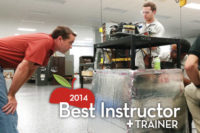Roughly 200 HVACR instructors from across the country recently came together for three days of training and networking at the 19th annual HVACR & Mechanical Conference for Education Professionals in Baltimore. The event, held this year at the Conference Center at the Maritime Institute, is sponsored by more than a dozen industry organizations, including Air-Conditioning, Heating, and Refrigeration Institute (AHRI); ACCA, Heating, Air-conditioning, and Refrigeration Distributors International (HARDI); the Association for Career and Technical Education (ACTE); ASHRAE; the Council of Air Conditioning and Refrigeration Educators (CARE); SkillsUSA; and North American Technician Excellence (NATE).
While the conference included numerous training sessions and presentations to help instructors hone their skills, it also provided an opportunity for attendees to bounce ideas off one another as they tried to solve the most pressing issue currently facing HVACR educators in the U.S. — how to attract new talent to the industry.
Strength in Numbers
In addition to training sessions on topics ranging from troubleshooting compressors to using PowerPoint in the classroom, the event also included panel discussions and keynote presentations from industry leaders. After featured speaker Dr. Brenda Dann-Messier, assistant secretary for career, technical, and adult education at the U.S. Department of Education, was unable to attend the event due to inclement weather, Jennifer Worth, director of the American Association of Community Colleges Center for Workforce & Economic Development, graciously stepped in at the last minute to discuss her organization’s role in supporting and advocating for the industry’s educational programs.
“There are lots of different words for what we are,” Worth said, referring to the nearly 1,200 community, state, vocational, and technical colleges in the U.S. that currently boast a combined 13 million students. “There is strength in our numbers.”
Worth offered support and resources to attendees and urged them to seek out funding from a variety of sources.
“There are billions of dollars out there that would be appropriate for you to go after,” she said, adding that both the Department of Education and the U.S. Department of Labor currently have grants and scholarships up for grabs.
“Grants.gov will tell you what the available opportunities are,” Worth added.
Warren Lupson, director of education at AHRI, agreed with Worth that HVAC educators need to take advantage of industry partnerships.
“If you’re not using us, you’re making a big mistake,” he told conference attendees. “Take this information back to your community college and give it to the program director or vice president. We need to start standing up for ourselves.”
“If you don’t talk about industry partners, it’s a loss,” Worth agreed. “If I can help bring money to your community, I’m really happy to do that.”
Help from Manufacturers
Robert Wilkins, vice president of public affairs at Danfoss, acknowledged that “one of the most critical issues facing our industry is the need for skilled HVACR technicians.” That’s why many manufacturers, including Danfoss, are taking steps to help bring new talent to the industry, he said.
“We’ve continued to develop more service-friendly kits that enable techs to service a range of products in the field so they don’t have to carry as much truck stock and can service multiple brands,” Wilkins explained. “We’ve put a QR code on the instructions so when the tech gets out there, he can scan that with his smartphone for more detailed instructions, including a video.”
Wilkins added that manufacturers’ organizations, including AHRI and the National Association of Manufacturers (NAM), are working to get the word out about industry jobs, too.
“AHRI is stepping up fundraising efforts to raise more money for scholarships,” Wilkins said, referring to the Clifford H. “Ted” Rees Jr. Scholarship, which awards approximately 15 annual scholarships of up to $2,000 each to qualified HVACR students.
“Training and outreach to technical schools are a priority for us, and we’re making some investments,” he added.
Solving a Problem
Lupson said bringing new talent to the HVACR industry will require industry-wide cooperation, though it’s the educators who have the most potential to make a difference as the “boots on the ground.”
“We need to be aggressive, and we need to want to help the industry,” Lupson said. “We need to speak to guidance counselors and parents in schools, and we need to tell the parents that it’s not a bad trade.”
Worth agreed that many parents have a misguided view of both the industry and the institutions that train and prepare students for employment. “They still think it’s cinder blocks and bad paint jobs, and that their kids are going to get a second-class experience, but that’s not true anymore,” Worth said. “Even in remote places, they’re thinking pretty progressively. This is a different day for community colleges.”
Worth added that getting guidance counselors to realize the benefits of attending a community college and pursuing a career in HVACR is much easier said than done.
“High school guidance counselors annoy me to no end,” she said. “There’s still that conversation that happens, where students have to go on and study philosophy or something, but that’s not what pays the bills. If you become a welder — let’s say, a titanium underwater welder — that’s six figures after two years. I really, very much believe we have to start elevating these types of conversations.”
Don Frendberg, executive director of the HVACR Workforce Development Foundation, also spoke during Worth’s presentation and urged conference attendees to take action.
“We need to be out in the schools, and we need to be talking to parents and guidance counselors. All these people are our target audience,” Frendberg said. “The major goal of the foundation is getting students into the technical and community colleges. We need to bring people into the HVACR industry. It’s our whole industry’s problem.”
Publication date: 3/24/2014
Want more HVAC industry news and information? Join The NEWS on Facebook, Twitter, and LinkedIn today!























